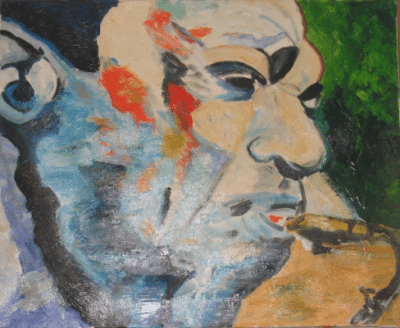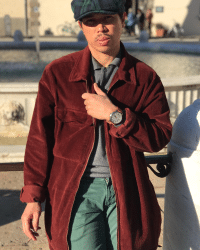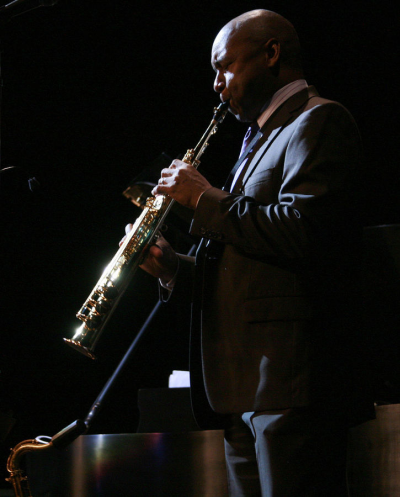.
.
photo by Jjb91, CC BY-SA 3.0/via Wikimedia Commons

John Coltrane
.
.
___
.
.
A Love Supreme (On John Coltrane)
by
Carlo Rey Lacsamana
.
…..Listen to Coltrane. His music is always destined to reach human intensity and tenderness. (I think of the albums My Favorite Things, Giant Steps, and A Love Supreme). Intensity and tenderness are, for him, interchangeable. Most of the time these two qualities intertwine in his improvisations. The quantity and quality of notes, the rhythmic variations, the dissonance and harmony that merge into a singular personality. This tells of the air that he blows through the instrument doesn’t simply come from his chest or belly. The source is much deeper. But less mysterious. This singular element lacking in most musicians today: the love of finding, of searching, of exploring the other music outside the known and accepted music is the music which ultimately must be heard, must be communicated. “Finding is the first Act,” wrote Emily Dickinson. For such a project it was necessary to pay attention to musical traditions of other cultures, to different points of views. He was a great listener as much as he was a great player. Perhaps the greatness of a musician lies not in originality (whose definition is too vague and arbitrary) but in his capacity for listening. I believe that’s what great musicians ultimately teach us: a wholehearted attitude towards listening. It takes love to really listen.
…..Sheets of sound. The plethora of notes that Coltrane blows is not to be mistaken as a kind of loquacity but rather an inherent need to speak. To say that which has been silenced by norms, laws, oppression, History. To speak the unspeakable. The Afro-American writer and Civil Rights activist, James Baldwin writes:
“In order to deal with the untapped and dormant force of the previously subjugated, in order to survive as a human, moving, moral weight in the world, America and all Western nations will be forced to reexamine themselves and release themselves from many things that are now taken to be sacred, and to discard nearly all the assumptions that have been used to justify their lives and their anguish and their crimes so long.”
…..The subversive quality of (his) music is its power to unveil the invisibility of emotions and ideas: in this case the black creative resources and resistance. Coltrane’s openness and playfulness, his generosity to let new ideas flow through him and manifest in his music is in itself an act of artistic civil disobedience: defying the thread of lethargy and conformism in the general cultural situation. His persistence to expand the framework of jazz through his compositions and improvisations demonstrates his quarrel with the status quo. The phrases of his solos–the way the notes are linked together and deviate from basic harmony–pose a challenge to the “protective sentimentality” of the listeners. His inventiveness cuts across dogmatic spaces and conventional beliefs. Improvisation was a way of breaking through cynicism and apathy.
…..Miles Davis was not being too generous when he would turn the spotlight to John’s interminable solos. Miles knew that John had something to say. And the latter tried to speak through several albums, and still speaking today through countless musicians influenced by him.
…..His music has the solemnity of a church sermon which echoes the rich spiritual tradition of black churches in America. Like his preacher father John Coltrane is a preacher with the saxophone. His playing and intonation resemble the energy and pitch of a preacher preaching to the community. His restless experimentation is tantamount to the endless search for truth, for answers to the social and psychological problems of a society built on ignorance and belligerence. He believed in the sanctity of the Sound as much as he believed in the sacredness of the Word.
…..Blues and jazz are music which emerged out of social indifference and inertia. They are confessional portraits of a people that fought for and believed in their own human worth. They are about creativity and love under the toughest and perilous conditions. The brilliant theologian, James Cone argues:
“the origin and definition of the blues cannot be understood independent of the suffering that black people endured in the context of white racism and hate… suffering and its relation to blackness is inseparable from the meaning of the blues.”
…..The link between Coltrane’s indefatigable search for new ways of improvising and the colossal struggle of Afro-American communities against white supremacy is telling. The deeper spirituality Coltrane pursued in music resonated with the social aspiration and hopes of his neglected community. The blues, as well as jazz, says the Afro-American intellectual, Cornel West, “professes to the deep psychic and material pains inflicted on black people within the sphere of a mythological land of opportunity.” Coltrane’s music can be heard (thought) of as expressive of the “commitment to the value of the individual and of speaking up about ugly truths; it asserts the necessity of robust dialogue.” Like the early blues musicians before him Coltrane struggled, in the face of society’s racial biases, to liberate and communicate the creative and spiritual resources inherent in black tradition to the wider community.
…..The artist’s creative force is perilous to state power. The danger of evoking new modes of feeling; of imagining; of being; of loving. Art can appease, but it can also disturb the status-quo of the mind. No wonder Plato was wary of admitting musicians to his ideal Republic. Coltrane’s music has all the stubborn qualities of subversiveness.
…..The experimental form he embraced in his later years was highly criticized, mocked as obscure, alienated many of his listeners and fellow musicians. Perhaps it was the logical conclusion of his successive acts of soul searching. That there is something more to be heard. Coltrane’s artistry is comparable to that of a master craftsman weaving an enormous basket which can hold an infinite variety of objects, emotions, ideas, circumstances, experiences, and what emerges from it is a kind of genuineness: a music that embraces all, as if “all made from one – all made in one”: the accompanying text to the fourth movement of A Love Supreme. His creative imaginative vigor broke through any dogmatic approach to music. He was cautious of fixation of ideas. He was always attempting to search for new sounds and their corresponding emotional meanings. He once said in an interview: “I would like to bring to people something like happiness.” Why happiness? There is something painfully sad to have lived in an environment where a certain group or community is systematically marginalized and oppressed by, in the words of Edward Said, “the imperialist power that would otherwise compel you to disappear or to accept a miniature version of yourself.” The overlap of Afro-American struggle and musical experience is the source of cultural identity for Coltrane. Through music he recovered a people’s sense of pride in one’s heritage; their presence that History has no power to make disappear.
.
.
___
.
.

Carlo Rey Lacsamana is a Filipino writer, poet, and artist born and raised in Manila, Philippines. Since 2005, he has been living and working in the Tuscan town of Lucca, Italy. He regularly contributes to journals in the Philippines, writing politics, culture, and art. His works have appeared inEsquire Magazine, Colossus Magazine, Drunkmonkeysweb, Amsterdam Quarterly, Lumpen Journal (London), The Wild World(Berlin),Literary Shanghai and in other numerous magazines. One of his stories has been recorded as a podcast story in the narrative podcast Pillow Talking (Australia).
Follow him on Instagram @carlo_rey_lacsamana
.
.
Listen to the 1964 recording of John Coltrane playing “Psalm,” from A Love Supreme; with McCoy Tyner (piano); Jimmy Garrison (bass); and Elvin Jones (drums). [Universal Music Group]
.
.
___
.
.
Click here for information on how to submit your work
Click here to subscribe to the Jerry Jazz Musician quarterly newsletter
Click here to help support the continuing publication of Jerry Jazz Musician
.
.
.








































Thank you for sharing with us the brilliance of a great man whose music superceded conventional jazz. John Coltrain explored the heavens for a sound beyond the spheres of social norms and boundaries. He communicated vision in making Giant Steps towards inclusion and harmony toward connecting man to God through a Love Supreme for the betterment human relationships.